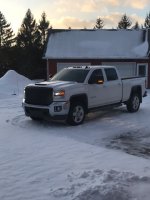wjtstudios
Hooked
In what style and size? I didn't see anything on their site that high.
The nitto Terra grappler in 295/60/20 also is 4080 and more of an AT instead of a MT tire.
Sent from my iPhone using WAYALIFE mobile app
In what style and size? I didn't see anything on their site that high.
Remember, axle ratings on single rear wheel is #7000. That is on a '16 F-350
Remember, axle ratings on single rear wheel is #7000. That is on a '16 F-350
Yes, with the right tires and skill driving, you can go higher, BUT, once the ratings are exceeded, you are at risk legally, and most insurance will not cover the problem.
When I was younger, I routinely hauled over the ratings on nearly everything I have owned, but I am older and I hope wiser now, so I don't admit to doing things like that anymore.[emoji6]
I'm just throwing it out there as a reminder of the risks when things go wrong.
Also, on the tire capacity, if you are within about 20% of the ratings, you are pushing it. Once near capacity, tires will start to sway and cause real problems, and speed makes it worse.
If you are pushing the limit, slow down, and make frequent stops to check tire and bearing temperatures.
Stay safe[emoji106]
Numbers for the new 2019 Ram 3500 came out today...
400 HP and 1000 TQ. 7,630# payload and 35,100# towing capacity!
That should do it!
Numbers for the new 2019 Ram 3500 came out today...
400 HP and 1000 TQ. 7,630# payload and 35,100# towing capacity!
That should do it!
2018 was 385/930.
My 2016 is 385/900.
So a small bump in both.
They came a long way. I had a 95 and it was rated at 160/400 and it was the king of the road at the time
They came a long way. I had a 95 and it was rated at 160/400 and it was the king of the road at the time
Nice! I would like to see more picture of how you mounted the camper! I have been interested in doing this for a while now.




Put the front cover on for the next 2 days
View attachment 319992
Here is our forecast
View attachment 319993
Sent from my iPhone using WAYALIFE mobile app
Good looking truck! I’ve seen those covers on vehicles around here and always wondered what they are for?
Put the front cover on for the next 2 days
View attachment 319992
Here is our forecast
View attachment 319993
Sent from my iPhone using WAYALIFE mobile app
